Freeze-Thaw Weathering and Degradation: The Effect on Pavements
by Piotr Mazurowski, on January 11, 2023
What is freeze-thaw weathering?
The process of freeze-thaw weathering occurs when water seeps into cracks in rocks or the pores between soil particles and freezes. The expansion of the water creates high pressures, which can widen the cracks or force apart the soil particles. When we look at the forces involved in frost shattering, it's easy to understand how this degradation process can happen. As water crystalizes during freezing, the increase in volume is slightly more than 9% and the expansion pressures generated if confined can exceed 220 MPa: more than enough to fracture rock.
What is a freeze-thaw cycle?
When air temperatures drop below freezing, the road and ground surfaces are cooled and eventually reach freezing causing water in the pavement to freeze. The longer the air temperature remains below freezing, the deeper the zone of freezing (usually called the frost zone). Frost can then penetrate deep into the subgrade soil beneath.
As air temperatures rise above freezing, the reverse effect occurs. Surface temperatures rise above zero, the ice thaws and the increased temperature slowly penetrates deeper into the pavement and soil beneath. Taken together, the phases of decreasing and increasing temperatures form one freeze-thaw cycle.
Where does freeze-thaw cycling occur?
In near-polar regions, air temperatures remain below freezing for long periods. There may be just one seasonal freeze-thaw cycle per year. However, in Northern and Southern Temperate zones, there are extended periods when air temperatures rise and fall between freezing for days or weeks at a time. In these regions, there are multiple freeze-thaw cycles per year.
What is the effect of climate change?
An effect of climate change is that some near-polar regions in Canada, Northern Europe and Russia, which normally experience one long, frigid season are experiencing more temperate conditions with multiple freeze-thaw cycles per year. Some regions that once had permafrost up to or close to ground level, now find that the permafrost has receded, resulting in subgrade soils and road foundations having to experience seasonal freeze-thaw cycles.
How does freeze-thaw weathering damage asphalt?
Micro effects: Freeze-thaw cycles have been shown to cause damage to the binder, affecting its properties and causing a reduction in stiffness, compressive strength, and fatigue resistance of the asphalt concrete. The percentage of voids within the mineral aggregate increases under freeze-thaw cycling, further reducing the stability of the asphalt.
Mezzo Effects: The presence of water freezing within the asphalt causes a reduction in the bond between binder and aggregate particles, this loss of adhesion referred to as ‘stripping’, continues under repeated freeze-thaw cycles.
Macro Effects: Water entering the asphalt through cracks expands during the freeze phase, bursting apart the asphalt and widening and lengthening cracks. This reduces the structural performance of the asphalt layer and eventually leads to potholes forming. The potholes widen rapidly under the action of further freeze-thaw cycles.
The impact of freeze-thaw cycles on subgrade soils and road foundations: frost heave and thaw weakening
The adverse effects of freeze-thaw on road pavements can be divided into two separate but related processes: frost heave and thaw weakening. Frost heave is the upward movement of the pavement resulting from the expansion as water in the pavement layers and subgrade freezes. Thaw weakening describes the weakening effect on the subgrade resulting from soil saturation as ice within the subgrade melts.
What is frost heave and how does it work?
 The formation of ice crystals within the larger voids between soil particles extend to form continuous ice lenses. Ice lenses grow through capillary rise and they thicken in the direction of heat transfer until all water is frozen.
The formation of ice crystals within the larger voids between soil particles extend to form continuous ice lenses. Ice lenses grow through capillary rise and they thicken in the direction of heat transfer until all water is frozen.
As water is frozen, a negative pore pressure develops in the pavement layers, which draws water upward from the lower unfrozen soil towards the frozen front. This phenomenon is known as ‘cryosuction’. As the ice lenses thicken, the overlying soil and pavement layers ‘heave’ upward.
The longer freezing temperatures are maintained at the surface, the deeper the zone of frost penetration, the thicker the ice lenses and the greater the overall volume of frost heave.
What are the conditions for frost heave?
For frost heave to occur, three conditions need to be met:
- The presence of materials which are frost susceptible. Many agencies chose to classify materials as being frost susceptible if 10% or more passes a 0.075 mm sieve or 3 percent or more passes a 0.02 mm sieve
- Ground temperatures below 32°F
- The presence of water.
What is the effect of frost heave?
The upward non-uniform soil heave lifts the pavement and induces bending stresses in the asphalt layer that can result in cracking. This bending effect can be aggravated by the weight of snow ploughed onto the road edges. Pavement damage caused by frost heave is a major problem in countries that experience frigid winter conditions, particularly on low volume roads with thinner asphalt layers.
What is thaw weakening and how does it work?
In a sudden spring thaw, as air temperatures rise above 32°F, the temperature within the pavement begins to rise, commencing from the surface. A temperature gradient develops through the pavement, extending into the frozen subgrade. As the ice melts in the upper zone of the subgrade, the soil immediately below is still frozen and impermeable, water is trapped in the thawed soil layer. The saturated subgrade layer is substantially weakened and its bearing capacity reduced. At this point, the pavement is highly susceptible to damage from traffic loading.
If there are several freeze-thaw cycles that extend to the subgrade, the effect is to loosen the upper subgrade soil, reducing density and stiffness. This then leads to even greater weakening after the final thaw takes place.
The 5 stages of thaw weakening
Illustrated below are the 5 stages of thaw weakening. The temperature gradient for each stage is superimposed over the pavement structure. After stage 5 the subgrade is in a very weak condition and the pavement is susceptible to failure under traffic loading. This can result in pavement cracking and severe surface rutting.
| Stage 1: Frozen Pavement | Stage 2: First Thawing |
|---|---|
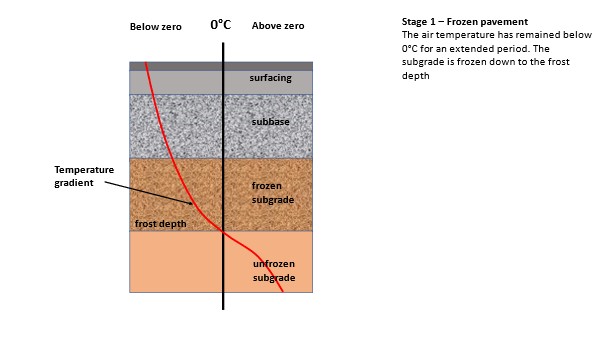 |
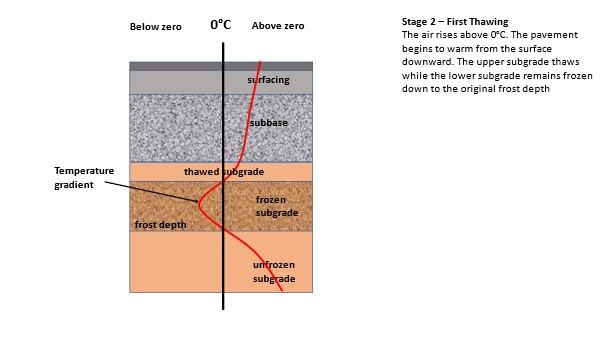 |
| Stage 3: Thaw Weakening | Stage 4: Re-freezing |
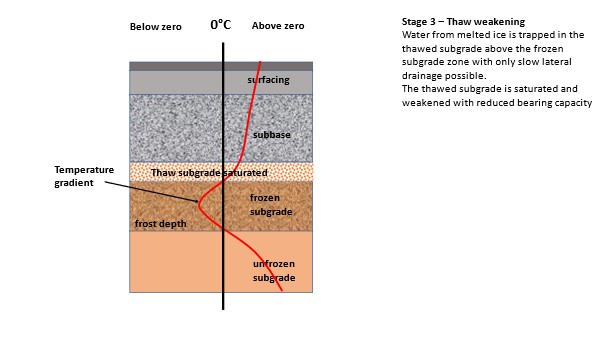 |
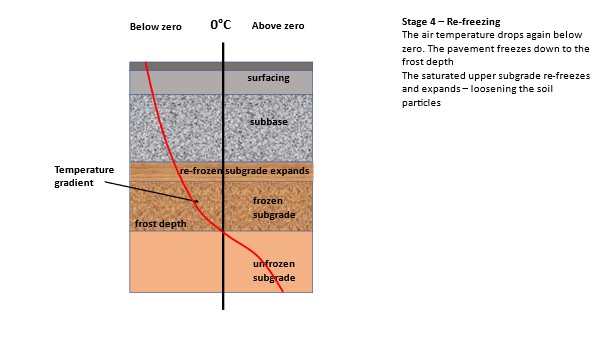 |
| Stage 5: Final Thaw | |
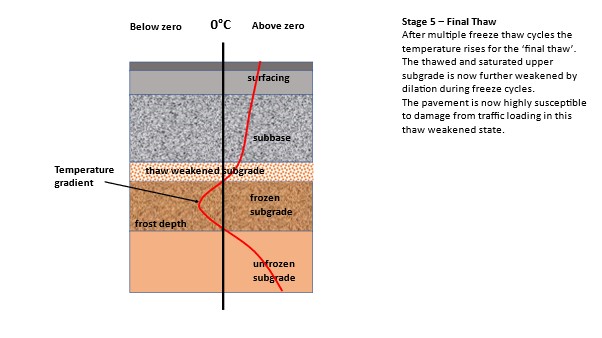 |
|
How Tensar Solutions Can Help
Tensar has developed solutions that are proven to tackle pavement problems associated with freeze-thaw cycles.
 Building Resilience: By incorporating Tensar InterAx geogrid above the subgrade surface to stabilize the sub-base layer in new construction, the pavement stiffness is increased and the weakened subgrade is protected during the spring thaw period.
Building Resilience: By incorporating Tensar InterAx geogrid above the subgrade surface to stabilize the sub-base layer in new construction, the pavement stiffness is increased and the weakened subgrade is protected during the spring thaw period.
Reducing the Cost of Reconstruction: When pavements fail due to severe thaw weakening of the subgrade, Tensar InterAx geogrid can be incorporated into the reconstruction to avoid the need for deep excavation of weak subgrade soils.
Improving the Life of Asphalt Overlays: When pavement surfaces have cracked due to frost heave and an overlay is planned, Tensar Asphalt Interlayer products can be employed to increase the life of the overlay by reinforcing the overlay to delay further cracking.



